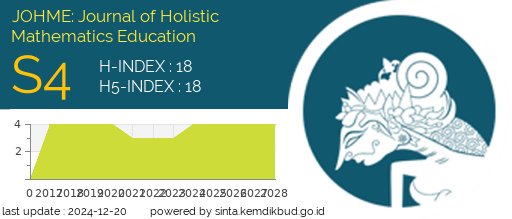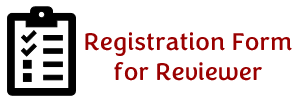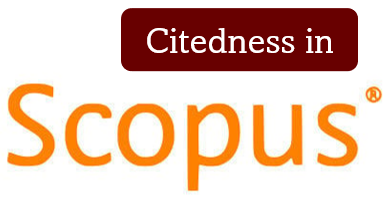IDENTIFIKASI KEMAMPUAN LITERASI NUMERASI MELALUI INSTRUMEN ASESMEN KOMPETENSI MINIMUM PADA SISWA SMA KELAS XI SMAS WARTA BAKTI KEFAMENANU [IDENTIFICATION OF THE NUMERICAL LITERACY ABILITY OF GRADE 11 STUDENTS AT WARTA BAKTI KEFAMENANU HIGH SCHOOL USING THE MINIMUM COMPETENCY ASSESSMENT INSTRUMENT]
DOI:
https://doi.org/10.19166/johme.v6i2.5751Keywords:
assessment of minimum competency, numeracy literacy, conceptual error, principal error, procedure error, asesmen kompetensi minimum, literasi numerasi, kesalahan konsep, kesalahan prinsip, kesalahan prosedurAbstract
One of the benchmarks of individual quality is seen in numeracy literacy skills. The purpose of this study was to identify the numeracy literacy skills of grade 11 students at Warta Bakti Kefamenanu High School, Nusa Tenggara Timur, in solving numeracy literacy problems with the minimum competency assessment (MCA) instrument in integral and domain algebra. This research was descriptive qualitative. This research technique was carried out with a test in the form of MCA, identifying the variations of errors made, identifying them in the types of errors, and mapping them to numeracy literacy indicators. Instrument items were taken from previous research and modified and content validity was done. The result of data analysis shows that participants who had principal errors met the numeracy literacy indicators item 1 and item 2, participants who had operating errors met the numeracy literacy indicator item 1, and participants who had conceptual errors did not meet all numeracy literacy indicators.
BAHASA INDONESIA ABSTRACT: Salah satu tolak ukur kualitas individu dilihat dari kemampuan literasi numerasi. Tujuan penelitian ini adalah mengidentifikasi kemampuan literasi numerasi siswa SMA Kelas XI SMAS Warta Bakti Kefamenanu, Nusa Tenggara Timur dalam menyelesaikan masalah literasi numerasi model instrumen asesmen kompetensi minimum (AKM) pada domain aljabar topik integral. Jenis penelitian ini adalah deskriptif kualitatif. Teknik penelitian ini dilakukan dengan tes berbentuk AKM, mengidentifikasi variasi kesalahan yang dilakukan, mengidentifikasinya ke dalam jenis/tipe kesalahan, dan memetakan pada indikator literasi numerasi. Untuk butir instrumen, diambil dari penelitian sebelumnya dan dimodifikasi kemudian dilakukan proses validitas isi. Hasil dari penelitian ini adalah partisipan yang memiliki kesalahan prinsip memenuhi indikator literasi numerasi butir 1 dan butir 2, partisipan yang memiliki kesalahan operasi memenuhi indikator literasi numerasi butir 1, dan partisipan yang memiliki kesalahan konsep tidak memenuhi semua indikator literasi numerasi.
References
Abidin, Y., Mulyati, T., & Yunansah, H. (2017). Pembelajaran literasi strategi
meningkatkan kemampuan literasi matematika, sains, membaca, dan menulis.
Jakarta, Indonesia: Bumi Aksara.
Alberta Education. (2018). Literacy and numeracy progressions. Retrieved from
https://education.alberta.ca/literacy-and-numeracy/
Abdurrahman, M. (2012). Anak berkesulitan belajar teori, diagnosis, dan remidiansinya. Jakarta, Indonesia: Rineka Cipta.
Abdussakir. (2018). Literasi matematis dan upaya pengembangannya dalam pembelajaran di kelas. Seminar Pendidikan Matematika, 1-16. Retrieved from http://repository.uin-malang.ac.id/2400/7/2400.pdf
Anwar, N. T. (2018). Peran kemampuan literasi matematis pada pembelajaran matematika abad-21. PRISMA: Prosiding Seminar Nasional Matematika, 1, 364-370. Retrieved from https://journal.unnes.ac.id/sju/index.php/prisma/article/view/19603/9527
Aulia, J., & Kartini. (2018). Analisis kesalahan siswa dalam menyelesaikan soal cerita pada materi himpunan bagi siswa kelas VII SMP. Jurnal Cendekia: Jurnal Pendidikan Matematika, 1(1), 60-65. https://doi.org/10.31764/pendekar.v1i1.280
Cahyana, A. (2020). Prospek AKM dan survei karakter: Memperkuat basis praliterasi dan pranumerasi usia dini. Retrieved from https://banpaudpnf.kemdikbud.go.id/upload/download-center/Prospek%20AKM%20dan%20survei%20karakter%20-%20memperkuat%20basis_1591186022.pdf
Klau, K. Y., Siahaan, M. M. L., & Simarmata, J. E. (2020). An identification of conceptual and procedural understanding: Study on preservice secondary mathematics teacher. Al-Jabar: Jurnal Pendidikan Matematika, 11(2), 339-350. https://doi.org/10.24042/ajpm.v11i2.7310
Leong, Y. H., Cheng, L. P., Toh, W. Y. K., Kaur, B., & Toh, T. L. (2021). Teaching students to apply formula using instructional materials: A case of a Singapore teacher’s practice. Mathematics Education Research Journal, 33(1), 89-111. https://doi.org/10.1007/s13394-019-00290-1
NCTM. (2014). Procedural fluency in mathematics. Retrieved from https://www.nctm.org/Standards-and-Positions/Position-Statements/Procedural-Fluency-in-Mathematics/
Novita, N., Mellyzar, M., & Herizal, H. (2021). Asesmen nasional (AN): Pengetahuan dan persepsi calon guru. JISIP: Jurnal Ilmu Sosial dan Pendidikan, 5(1), 172-179. https://doi.org/10.36312/jisip.v5i1.1568
Rianti, M. R., Toheri, T., & Kusmanto, H. (2022). Mathematical literacy ability based on higher level thinking. Journal of Medives: Journal of Mathematics Education IKIP Veteran Semarang, 6(1), 21-38. https://doi.org/10.31331/medivesveteran.v6i1.1836
Ridzkiyah, N., & Effendi, K. N. S. (2021). Analisis kemampuan literasi matematis siswa sma dalam menyelesaikan soal program for international student assessment (PISA). JIPMat, 6(1), 1-13. https://doi.org/10.26877/jipmat.v6i1.8237
Rizki, L. M., & Priatna, N. (2019). Mathematical literacy as the 21st century skill. Journal of Physics: Conference Series, 1157, 1-6. https://doi.org/10.1088/1742-6596/1157/4/042088
Susanta, A., Sumardi, H., & Zulkardi. (2022). Development of mathematical literacy problems using Bengkulu context. Proceedings of the Eighth Southeast Asia Design Research (SEA-DR) & the Second Science, Technology, Education, Arts, Culture, and Humanity (STEACH) International Conference (SEADR-STEACH 2021), 627, 182-188. https://doi.org/10.2991/assehr.k.211229.029
Tokada, D., Herman, T., & Suhendra. (2017). Discovery learning for mathematical literacy ability. Journal of Physics: Conference Series, 895, 1-6. https://doi.org/10.1088/1742-6596/895/1/012077
Tyas, F., & Pangesti, P. (2018). Menumbuhkembangkan literasi numerasi pada pembelajaran matematika dengan soal HOTS. Indonesian Digital Journal of Mathematics and Education, 5(9), 566-575. Retrieved from http://idealmathedu.p4tkmatematika.org/articles/IME-V5.9-21-Pangesti.pdf
Utami, R. A. S., Widodo, J. S., Siagian, T. H., & Ragamustari, S. K. (2020). Numerical literacy among senior high school students at alumni course institution in Jakarta branch: Critical literacy in numeral data interpretation. Proceedings of the International University Symposium on Humanities and Arts 2020, 593, 247-253. Retrieved from https://www.atlantis-press.com/article/125962581.pdf
Zain, A. N., Supardi, L., & Lanya, H. (2017). Analisis kesalahan siswa dalam menyelesaikan soal matematika materi trigonometri. Jurnal Inovasi Pendidikan dan Pembelajaran Matematika, 3(1), 12-16. Retrieved from http://ejournal.unira.ac.id/index.php/jurnal_sigma/article/view/336/283
Downloads
Additional Files
Published
How to Cite
Issue
Section
License
Authors who publish with this journal agree to the following terms:
1) Authors retain copyright and grant the journal right of first publication with the work simultaneously licensed under a Creative Commons Attribution License (CC-BY-SA 4.0) that allows others to share the work with an acknowledgement of the work's authorship and initial publication in this journal.
2) Authors are able to enter into separate, additional contractual arrangements for the non-exclusive distribution of the journal's published version of the work (e.g., post it to an institutional repository or publish it in a book), with an acknowledgement of its initial publication in this journal.
3) Authors are permitted and encouraged to post their work online (e.g., in institutional repositories or on their website). The final published PDF should be used and bibliographic details that credit the publication in this journal should be included.”










